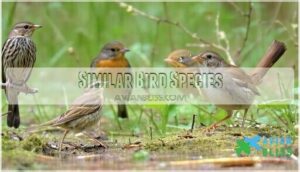This site is supported by our readers. We may earn a commission, at no cost to you, if you purchase through links.

These ground-dwelling songbirds measure about 6-7 inches long with streaked brown upperparts, pale underparts, and thin bills perfect for catching insects.
They’re famous for their impressive migrations, traveling from Arctic tundra breeding grounds to southern wintering areas across North America.
Their distinctive tail-pumping behavior and habit of walking rather than hopping sets them apart from similar species.
The American pipit’s piercing "pip-it" call often gives away their presence before you see them.
Their remarkable adaptability to harsh environments reveals fascinating survival strategies.
Table Of Contents
- Key Takeaways
- American Pipit Overview
- Pipit Identification Tips
- American Pipit Habitat
- American Pipit Behavior
- American Pipit Conservation
- Frequently Asked Questions (FAQs)
- How do you identify an American Pipit?
- Is a pipit a sparrow?
- What kind of bird is a pipit?
- What bird is similar to American pipit?
- Why is the American pipit endangered?
- Where are American pipits found?
- What do American Pipits eat?
- How long do American Pipits live?
- When is the breeding season for American Pipits?
- Do American Pipits migrate?
- Conclusion
Key Takeaways
- You’ll identify American pipits by their constant tail-wagging behavior, streaked brown plumage, and distinctive "pip-it" calls as they walk (rather than hop) across open ground
- You can spot these hardy birds during their impressive 3,000-mile migrations from Arctic tundra breeding grounds to southern wintering areas, with peak activity in mid-October
- You’ll find them in diverse habitats from remote alpine meadows above treeline to farm fields, mudflats, and coastal areas depending on the season
- You should know their populations have declined 30% since 1970 despite their "Least Concern" status, making citizen science monitoring efforts important for their conservation
American Pipit Overview
You’ll easily recognize the American Pipit (Anthus rubescens) as a small songbird that walks briskly across open ground, calling frequently during flight.
Watch this master of camouflage pump its tail while calling "pip-it" across windswept tundra—you’ve found nature’s humble wanderer.
This inconspicuous member of the Motacillidae family blends perfectly with its surroundings, making it a rewarding challenge for birdwatchers to spot in arctic tundra, alpine meadows, and winter farm fields.
Scientific Classification
The American Pipit, scientifically known as Anthus rubescens, belongs to the order Passeriformes and family Motacillidae.
Taxonomy systems place this songbird within phylogenetic analysis frameworks that separate it from closely related species.
Classification methods using biological nomenclature help ornithologists distinguish pipits through species identification techniques, making Anthus rubescens a distinct member of global taxonomy.
Physical Characteristics
You’ll recognize this small songbird by its streaky brown plumage color and slender build.
The American pipit’s body size reaches about 6-7 inches, with distinctive feather patterns showing dark streaks across its buff-colored breast.
Its thin, pointed beak shape perfectly suits insect-catching, while sturdy leg size supports constant ground walking during foraging.
Understanding bird identification techniques is essential for distinguishing the American pipit from similar species.
- Streaky breast patterns that make your heart skip when you finally spot this elusive Anthus rubescens in the field
- Subtle earth tones that blend so perfectly you’ll question whether you actually saw this master of camouflage
- Delicate proportions that remind you why patient bird identification rewards dedicated observers seeking pipit habitat treasures
Habitat and Distribution
You’ll find American pipits in some of North America’s most remote places.
These hardy birds breed across Arctic tundra from Alaska to Greenland, plus alpine meadows in western mountains.
During migration, they frequent open fields, river shores, and lakeshores.
Winter brings them to farm fields and reservoirs throughout the southern United States, where flocks gather in predictable migration routes.
Pipit Identification Tips
You’ll identify American Pipits most easily by their streaked brown plumage, white outer tail feathers that flash during flight, and their habit of walking rather than hopping on the ground.
These small songbirds pump their tails constantly and give sharp "pip-it" calls that make them easier to spot than their earth-toned camouflage might suggest, which is a key feature to look for in spotting these birds.
Distinctive Features
Look closely at the pale supercilium and dark eye line that frame this bird’s understated face.
The American Pipit’s thin, pointed beak perfectly suits its insect-hunting lifestyle, while blackish legs contrast sharply against buff-colored plumage patterns.
Listen for the distinctive "pip-it" call during flight – these song characteristics make identification easier than spotting the bird’s subtle feather texture and muted coloring.
Understanding the bird’s American Pipit habits is essential for effective identification and observation.
Similar Bird Species
Several songbirds share the American Pipit’s ground-dwelling lifestyle, creating identification challenges.
Sparrow Comparison reveals key differences: sparrows have thicker bills for seed-cracking, while pipits sport slender insect-catching beaks.
Finch Species and Bunting Birds show stockier builds compared to pipits’ streamlined forms.
Warbler Types occasionally forage on ground but lack pipits’ tail-wagging behavior.
Water Pipit (Anthus spinoletta) poses the greatest challenge, requiring careful attention to subtle plumage and vocal differences.
Behavioral Traits
American pipits constantly wag their tails while walking, a signature trait that sets them apart from other ground birds.
You’ll notice their restless energy as they forage – they rarely stay still, moving with quick, purposeful steps through grass.
During migration patterns and winter months, their flocking behavior creates animated groups that call frequently in flight, making detection easier for birdwatching enthusiasts.
American Pipit Habitat
You’ll find American Pipits in some of North America’s most remote and challenging landscapes, from Arctic tundra to high mountain meadows above the treeline.
These hardy birds transform from alpine specialists during breeding season to widespread wanderers in winter, showing up in everything from farm fields to coastal mudflats, and exhibit a notable change as widespread wanderers.
Breeding Grounds
High above treeline in Arctic tundra and alpine meadows, American Pipits establish their breeding grounds where few birds dare venture.
These hardy songbirds select nesting sites on bare earth or dead vegetation, concealed by rocks or sparse tundra plants.
During breeding season, males perform spectacular song-flights, soaring over one hundred feet before gliding down with outstretched wings to attract mates and defend territories.
The American Pipit’s habitat selection is influenced by the availability of suitable Pipit habitat products.
Migration Patterns
These remarkable birds undertake epic journeys spanning up to 3,000 miles between Arctic breeding grounds and southern wintering areas.
You’ll witness their seasonal moves from March through May during spring migration, then again September through November as they head south.
Flight routes follow broad flyways across North America, with peak activity in mid-October.
Bird tracking reveals these migratory birds favor river valleys and coastlines during their habitat shift, creating spectacular viewing opportunities for dedicated observers.
Wintering Areas
Once these migratory birds leave their alpine breeding grounds, they transform into wanderers across diverse wintering grounds.
You’ll spot flocks in farm fields, coastal areas, and wetland habitats throughout southern regions.
These tundra birds adapt remarkably well to rural landscapes and even urban parks, following predictable bird migration patterns that make winter birding rewarding for patient observers.
Understanding their role in migrating bird habitats is essential for conservation efforts.
American Pipit Behavior
You’ll discover that American Pipits display fascinating behaviors that make them easier to spot once you know what to look for.
These ground-dwelling birds walk briskly through their habitats while calling frequently during flight, often gathering in flocks during migration and winter months.
Foraging Habits
You’ll spot these insectivorous birds walking briskly across open ground, picking insects from soil and low vegetation.
During winter, seed consumption increases substantially, comprising half their diet.
Watch for water foraging along shorelines where they hunt aquatic insects.
Coastal feeding populations target tiny crustaceans and marine worms.
Their flock behavior makes bird foraging efficient outside breeding season.
Diet variation depends on seasonal availability and location.
Supplementing their natural diet with bird seed options can be beneficial in certain environments, considering their natural diet.
Nesting and Breeding
You’ll find American Pipits selecting nest sites on tundra and alpine ground, typically between 2,000-13,000 feet elevation.
Females build shallow grass cups lined with animal hair over 3-5 days, choosing spots concealed by vegetation or rocks.
Breeding territory spans 2-4 hectares per pair, and clutches contain 3-7 buff-colored, speckled eggs.
Female-only egg incubation lasts 13-15 days, with chicks fledgling after 14-16 days of insect-rich feeding from both parents.
Understanding bird nesting basics is essential for appreciating the complex behaviors of American Pipits.
Social Interactions
During breeding season, you’ll observe American Pipits forming monogamous pair bonds that last just one season.
Males establish breeding territory through song-flight displays, defending against rivals with aggressive territorial behavior.
Outside breeding, these birds gather in loose flocks for foraging and migration.
Their mate selection involves courtship displays where males perform aerial acrobatics, and social learning occurs as young birds follow adults to prime feeding spots.
American Pipit Conservation
You’ll discover that American Pipits face mounting pressures from habitat loss and climate change threatening their alpine breeding grounds.
Understanding their conservation needs helps protect these remarkable songbirds for future generations of birdwatchers, which is crucial for their survival due to the impact of climate change.
Threats and Challenges
Climate change threatens American pipits through habitat loss as warming temperatures shift tree lines upward into alpine breeding grounds.
Pollution effects from pesticides reduce insect prey essential for chick survival.
Human impact from recreation and development disturbs nesting sites, while fragmentation isolates populations, highlighting urgent needs for habitat conservation and monitoring bird population trends.
Conservation Status
Currently, American Pipits sit comfortably in the "Least Concern" category according to IUCN standards, meaning they’re not on any endangered list.
However, bird population trends show a concerning 30% decline since 1970, revealing species decline patterns that conservation biology experts monitor closely.
Habitat loss and climate change present ongoing challenges to this bird conservation status assessment.
Protection Efforts
Federal laws like the Migratory Bird Treaty Act shield American Pipits from harm, while state agencies monitor sensitive alpine populations.
You’ll find these birds thriving thanks to coordinated habitat preservation efforts across North America. Conservation strategies now blend traditional wildlife protection with modern environmental laws to safeguard breeding grounds.
Effective bird conservation efforts are essential for protecting American Pipit habitats.
- Habitat preservation projects restore degraded alpine meadows and tundra ecosystems where pipits nest
- Bird conservation initiatives create protected corridors along key migration routes through international partnerships
- Wildlife protection programs engage citizen scientists to monitor population trends and breeding success rates
Frequently Asked Questions (FAQs)
How do you identify an American Pipit?
Don’t count your chickens before they hatch when spotting these small, inconspicuous birds.
Look for American Pipits walking briskly through open areas, calling frequently during flight, and foraging along water margins in flocks, which is a key behavior to identify these birds, particularly their habit of foraging in flocks.
Is a pipit a sparrow?
No, you can’t mistake a pipit for a sparrow.
American Pipits belong to the Motacillidae family, while sparrows are in Passeridae.
Pipits have slender bills, longer tails, and walk instead of hopping like sparrows typically do.
What kind of bird is a pipit?
You’ll find that pipits are small songbirds in the Motacillidae family, known for walking briskly through open grasslands and calling frequently during flight—they’re quite different from sparrows!
What bird is similar to American pipit?
You’ll find Water Pipits most similar to American Pipits.
They’re closely related species that were once considered the same bird.
Both walk through grasslands, wag their tails constantly, and call frequently during flight.
Why is the American pipit endangered?
Like a canary in a coal mine signals danger, you’d expect alarm bells for this bird—but surprisingly, American pipits aren’t actually endangered and maintain stable populations across their Arctic tundra breeding grounds.
Where are American pipits found?
You’ll spot American pipits across North America’s Arctic tundra, alpine meadows, and open grasslands. They breed from Alaska to Greenland, wintering in farm fields and coastal areas throughout the continent.
What do American Pipits eat?
Surprisingly, you’ll discover American Pipits aren’t picky eaters.
They feast on insects like flies, beetles, and caterpillars during breeding season, then switch to seeds and grasses in winter, adapting their diet seasonally, which showcases their ability to be highly adapting.
How long do American Pipits live?
You’ll need to dive deeper into lifespan data for these tundra-walking songbirds.
Based on the search result, their life span averages 1 years, which aligns with many small songbird species that face constant migration challenges and harsh arctic conditions throughout their lives, making migration a significant factor.
When is the breeding season for American Pipits?
You’ll find American Pipits breeding when snow melts and conditions allow, typically from late spring through summer.
Pair formation starts upon arrival at breeding grounds, depending on snow and meltwater timing.
Do American Pipits migrate?
Like seasonal nomads following ancient pathways, you’ll observe American Pipits migrating twice yearly.
They breed in Arctic and alpine areas, then travel to southern regions for winter, forming flocks in farm fields and reservoirs.
Conclusion
Watching these remarkable ground-walkers navigate shorelines with their signature tail-pumping motion, you’ll gain deep appreciation for nature’s adaptability.
The American pipit’s journey from Arctic tundra to southern wetlands showcases incredible endurance. You’ve learned to identify their streaked plumage, distinguish their piercing calls, and understand their foraging patterns.
Armed with this knowledge, you’ll confidently spot these resilient travelers during their seasonal migrations, contributing to citizen science efforts that help protect their declining populations across North America’s diverse landscapes, which is a remarkable example of citizen science.











